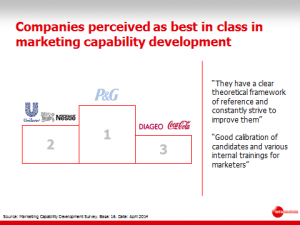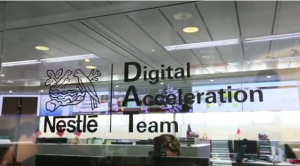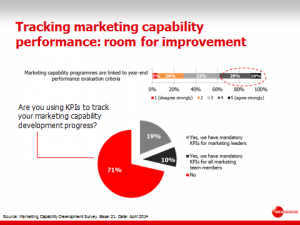It’s easy to get sucked into the hot topics around marketing but what brands really need are excellent capabilities across all key areas of marketing.
 In today’s marketing landscape new buzzwords emerge every day. “Big Data” is an obvious one and other terms such as ‘agile marketing’, ‘micro-video’, ‘brand newsroom’ and ‘viewability’, are also now catching the imagination of marketers.
In today’s marketing landscape new buzzwords emerge every day. “Big Data” is an obvious one and other terms such as ‘agile marketing’, ‘micro-video’, ‘brand newsroom’ and ‘viewability’, are also now catching the imagination of marketers.
But while marketing buzzwords come and go, the term “Marketing capabilities” has become an integral part of the industry jargon. Why? Because the companies that employ this term are those who give marketing a more strategic role in their company, fully recognising that a well-thought out marketing capability strategy can directly lead to business growth, and even lead growth.
In a recent survey conducted by WFA and MLA Consulting on the status of marketing capabilities, 71% of respondents indicated that marketing was key for company growth. However, 54% thought that their organisation did not have a world-class marketing team. This shows a clear gap where marketing is increasingly perceived as a critical function but not yet equipped in an optimal way to win the battle against companies such as P&G, Unilever, Nestlé, Diageo and Coca-Cola (the top five companies perceived a ‘best in class in marketing capability development’ in that same survey).
But let’s have a closer look at what marketing capabilities means. Almost 60% of respondents said their organisation has a clear definition but the definitions shared by our respondents show that the term means something very different to everybody. One common misconception is to reduce the scope of marketing capabilities to training/ skill gapping (57% of respondents confirmed this is the case in their company).
Although every company has different needs, the definition given by our friends at SPIRE could be a good starting point for creating industry-wide common ground. SPIRE defines marketing capabilities as “the abilities and talents the marketing function require to successfully deliver the business strategy at all stages of the business cycle i.e. from planning, through execution to review”.
They also highlight the importance of the word ‘function’ in their definition to go beyond the skill set of individual members of the marketing team and encompass team organisation and structure, ways of working within the team and with internal and external partners and also the overall culture and leadership behaviours for the team. It’s much more than just training, which is about the individual members of the team.
Our survey also suggests that common areas where marketing capability falls short are CRM, Content/ storytelling, Shopper marketing, Digital integration and Marketing innovation.
When we discussed this topic at our IMC FORUMs in London and Singapore earlier on this year, some of members shared recent initiatives that were helping to develop marketing capability programmes.
 One practice widely used by WFA members is the creation of internal marketing capability programmes. Nestlé, for example, created their ‘Digital Acceleration Team’ programme in 2012 in order to embed digital and social media into everything they do. Any employee could apply to join the team and eleven participants (picked by a Committee made up of HR and Digital Heads) were sent to the Nestlé’s headquarters in Switzerland for eight months every year.
One practice widely used by WFA members is the creation of internal marketing capability programmes. Nestlé, for example, created their ‘Digital Acceleration Team’ programme in 2012 in order to embed digital and social media into everything they do. Any employee could apply to join the team and eleven participants (picked by a Committee made up of HR and Digital Heads) were sent to the Nestlé’s headquarters in Switzerland for eight months every year.
For two months they were trained before working on real ‘digital speed’ projects for the remainder of the programme. The aim was to turn them into both trainers and local champions able to return to their home office and become Digital Leads, transferring knowledge and effectively transforming local digital initiatives.
Other members also use externship programmes where their employees are sent to other companies (non-competing organisations, suppliers and media owners) to better understand their business and collaborate on projects on a short to medium-term basis.
One memer has created a ‘Google Creative Academy’, a one week immersion into Google technology that sees teams made up of the member-Google-creative agency employees competing on real projects and pitching to a committee of experts. The winning team gets their idea implemented.
Another member shared his company adopted a Dragon’s Den approach where any marketing employee can pitch their idea to an internal panel. The winning candidate would then receive 50% of the requested amount and the remainder 50% would be covered from the employee’s team marketing budget. This has proven to be a successful initiative, fostering innovation and highlighting high-potential marketing talents. The 50-50 funding system ensures that the boss of successful applicants feels accountable for the project and therefore delivers on results.
The common thread of these initiatives is that they put highly motivated employees in the spotlight. They create a sense of collaboration and unity within the company and with partners. Far from being considered as a ‘one shot’, the results are long lasting and the output ultimately benefits the whole business.
 As marketers start to grasp the potential of marketing capability to drive growth, KPIs that measure and track performance in this area will also become essential. The current picture suggests that 71% of respondents do not currently use any mandatory KPIs to track their marketing capability development progress. A minority does, though: 19% have mandatory KPIs for marketing leaders and only 10% use mandatory KPIs for all marketing team members.
As marketers start to grasp the potential of marketing capability to drive growth, KPIs that measure and track performance in this area will also become essential. The current picture suggests that 71% of respondents do not currently use any mandatory KPIs to track their marketing capability development progress. A minority does, though: 19% have mandatory KPIs for marketing leaders and only 10% use mandatory KPIs for all marketing team members.
The truth is, embracing change requires time, especially in bigger companies. At a recent WFA meeting, one member shared his experience of leading the IMC agenda globally in two multinationals and pointed out that creating a brand new marketing capability programme can take up to five years when development and implementation are included. I also recently had an informal conversation with a member who was given a three-year mandate for this process but the time taken will clearly depend on many factors including company scale, culture and senior-level mandate for change.

